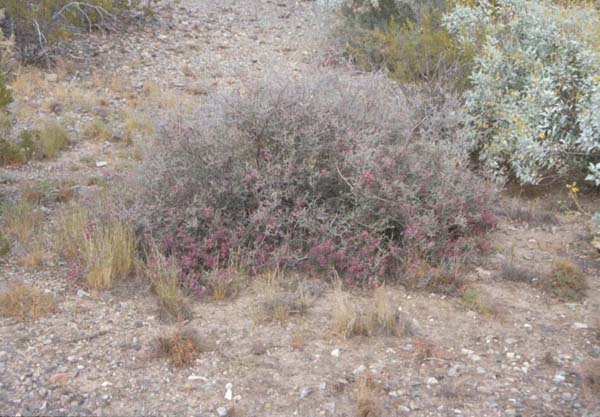|
Family: Krameriaceae |
PLANT: Shrubs and perennial herbs, hemiparisitic at least in AZ, vestiture variable, usually very dense on new growth. LEAVES: alternate, exstipulate, simple (in ours) or trifoliolate, sessile, linear to linear-lanceolate (in ours), the margins entire; apices acute or mucronate. INFLORESCENCE: uniflorous in leaf axils, terminal racemes or open panicles. FLOWERS: zygomorphic, perfect; peduncles and pedicels separated from each other by a pair of opposite, linear or lanceolate, leaf-like bractlets; sepals 4-5, of different lengths, showy, lanceolate to ovate, acute, imbricate, variably vestitured on the outer surfaces; petals 4 or 5, small, not showy, dimorphic; upper 3(2) petals petaloid, clawed or lanceolate, clustered at the base of the upper side of the ovary forming a “flag,” either free or connate basally; lower 2 petals smaller, fleshy, sessile, and dorsally modified into oil-secreting glands called elaiophores; stamens 3 or 4, the filaments stout, inserted at the junction of the upper petals and the ovary or on the connate portion of the petaloid petals, the anthers conical, the base slightly larger in diameter than the filaments, dehiscing by terminal, membranous pores; ovary superior, ovoid, densely pubescent, 1-loculed at maturity; style stout, about the same length as the ovary, glabrous (in ours); stigma minute; ovules 2, apical. FRUIT: a 1-seeded hard capsule, bladder-like when seeds abortive or fruit immature, bearing spines (rarely spineless) usually with retrorse barbs or glochids along the terminal end of the spines. SEEDS: globose, gray-brown, smooth, lacking endosperm. n = 6 (in ours). NOTES: A monogeneric family, 18 spp., s US to n Argentina and n Chile, primarily neotropical in open arid or seasonally dry habitats. REFERENCES: Simpson, Beryl B. Andrew Salywon. 1999. Krameriaceae. Ariz. - Nev. Acad. Sci. 32(1). |


